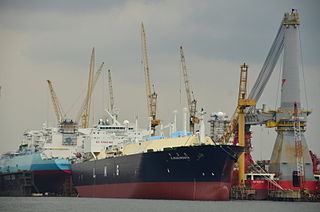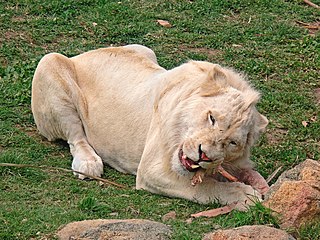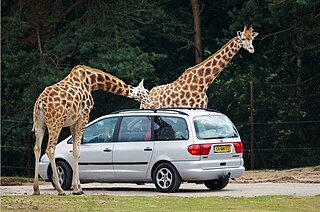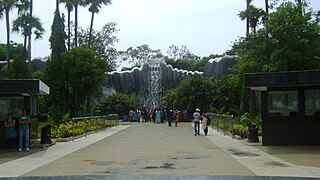
Maasai Mara, also sometimes spelled Masai Mara and locally known simply as The Mara, is a large national game reserve in Narok, Kenya, contiguous with the Serengeti National Park in Tanzania. It is named in honor of the Maasai people, the ancestral inhabitants of the area, who migrated to the area from the Nile Basin. Their description of the area when looked at from afar: "Mara" means "spotted" in the local Maasai language, due to the many short bushy trees which dot the landscape.

Tourism in Singapore is a major industry and contributor to the Singaporean economy, attracting more than 19.1 million international tourists in 2019, more than three times Singapore's total population. It is also environmentally friendly, and maintains natural and heritage conservation programs. Along with this, it also has one of the world's lowest crime rates. As English is the dominant one of its four official languages, it is generally easier for tourists to understand when speaking to the local population of the country as a lingua franca, for example, when dining and shopping. Transport in Singapore exhaustively covers most, if not all public venues in Singapore, which increases convenience for tourists. This includes the well-known Mass Rapid Transit (MRT) system. Singapore is the 5th most visited city in the world, and 2nd in Asia-Pacific.

The Singapore Zoo, formerly known as the Singapore Zoological Gardens or Mandai Zoo, occupies 28 hectares on the margins of Upper Seletar Reservoir within Singapore's heavily forested central catchment area. The zoo was built at a cost of $9 million granted by the government of Singapore and opened on 27 June 1973. It is operated by Wildlife Reserves Singapore, who also manage the neighbouring Night Safari, River Safari and the Jurong Bird Park. There are about 315 species of animal in the zoo, of which some 16 percent are considered to be threatened species. The zoo attracts over 2 million visitors every year.

The Night Safari is the world's first nocturnal zoo and is one of the most popular tourist attractions in Singapore.

Australia Zoo is a 700-acre (280 ha) zoo located in the Australian state of Queensland on the Sunshine Coast near Beerwah/Glass House Mountains. It is a member of the Zoo and Aquarium Association (ZAA), and is owned by Terri Irwin, the widow of Steve Irwin, whose wildlife documentary series The Crocodile Hunter made the zoo a popular tourist attraction.

Jurong Bird Park is an aviary and tourist attraction in Jurong, Singapore. The bird park covers an area of 0.2 square kilometres on the western slope of Jurong Hill, the highest point in the Jurong region. It is one of the parks managed by Wildlife Reserves Singapore with Singapore Zoo, Night Safari and River Safari.

The North Region of Singapore is one of the five regions in the city-state. The region is the second largest region in terms of land area, and has a population of 582,330. Woodlands is the regional centre and also the most populous town with 255,130 residents living in the area. Comprising 13,500 hectares of land area, it includes eight planning areas.

The white lion is a rare color mutation of the lion, specifically the Southern African lion. White lions in the area of Timbavati are thought to have been indigenous to the Timbavati region of South Africa for centuries, although the earliest recorded sighting in this region was in 1938. Regarded as divine by some African cultures, white lions first became known to the English-speaking world in the 1977 through the book The White Lions of Timbavati.

A safari park, sometimes known as a wildlife park, is a zoo-like commercial drive-in tourist attraction where visitors can drive their own vehicles or ride in vehicles provided by the facility to observe freely roaming animals.

Mandai is a planning area located in the North Region of Singapore, famously known for being the access point of the Singapore Zoo and Night Safari.

Jurong Bird Park Panorail was a 1.7-kilometre (1.1 mi) loop monorail system which ran within the Jurong Bird Park in Singapore. The system was constructed by Von Roll of Switzerland, who also built the Sentosa Monorail and Singapore Cable Car.

The River Safari is a river-themed zoo and aquarium located in Singapore. It is built over 12 hectares and nestled between its two counterparts, the Singapore Zoo and the Night Safari, Singapore. It is the first of its kind in Asia and features freshwater exhibits and a river boat ride as its main highlights. The safari was built at a cost of S$160m, with an expected visitor rate of 820,000 people yearly.

Arignar Anna Zoological Park, also known as the Vandalur Zoo, is a zoological garden located in Vandalur, is in the southwestern part of Chennai, Tamil Nadu, about 31 kilometres (19 mi) from the Chennai Central and 15 kilometres (9.3 mi) from Chennai Airport. Established in 1855, it is the first public zoo in India. It is affiliated with the Central Zoo Authority of India. Spread over an area of 602 hectares, including a 92.45-hectare (228.4-acre) rescue and rehabilitation centre, the park is the largest zoological park in India. The zoo houses 2,553 species of flora and fauna across 1,265 acres (512 ha). As of 2012 the park houses around 1,500 wild species, including 46 endangered species, in its 160 enclosures. As of 2010, there were about 47 species of mammals, 63 species of birds, 31 species of reptiles, 5 species of amphibians, 28 species of fishes, and 10 species of insects in the park. The park, with an objective to be a repository of the state's fauna, is credited with being the second wildlife sanctuary in Tamil Nadu after Mudumalai National Park.

The Central Water Catchment, also known as the Central Catchment Area, is a designated planning area and one of the two main water catchments of Singapore. The country's main reservoirs – MacRitchie, Upper Seletar, Upper Peirce and Lower Peirce – are in the central catchment area.
The Mandai Wildlife Bridge is an ecological bridge in Singapore. It links portions of the Central Catchment Nature Reserve that are otherwise separated by the Mandai Lake Road.













